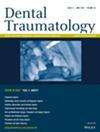Stress Distribution in Proclined Anterior Teeth of Pediatric Patients With and Without Mouthguard Use: A 3D Finite Element Analysis
Abstract
Background
Traumatic dental injuries related to sports are a significant concern, as they can have severe physical and psychological impacts on children. Using mouthguards is essential, particularly in sports like skating, where high-impact forces are common.
Aim
The study aimed to evaluate how stress is distributed on the teeth and surrounding bone in children with proclined anterior teeth when a force of 614.12 N was applied to two different regions of the jaws. The evaluation was conducted using finite element analysis (FEA), both with and without the use of a mouthguard.
Methods and Methodology
A 3-dimensional finite element analysis (FEA) model was constructed using a cone beam computed tomography (CBCT) scan of a 12-year-old male patient. An average standardized force of 614.12 N was calculated, based on the average weight of children aged 11 to 13 years and the average speed of 13.4 m/s with which the children skate. The force was applied in two different directions and areas of the jaws: a lateral blow, perpendicular to the crown and root with the maxillary and mandibular teeth in occlusion (between the first molar and second premolar), and a blow obliquely at the pogonion point on the chin. Static simulations were then performed for four realistic scenarios—two with mouthguards and two without mouthguards.
Result
The Von Mises stresses were evaluated under all conditions. When the applied force was directed laterally, the stress values observed were 126.76 MPa with a mouthguard and 140 MPa without a mouthguard. When the force was applied to the chin region, the stress values were 37.997 MPa with a mouthguard and 40.67 MPa without a mouthguard.
Conclusion
The use of a mouthguard in children is beneficial for protecting teeth and surrounding structures, especially in cases of proclined anterior teeth, as it helps dampen the generated stresses.

 求助内容:
求助内容: 应助结果提醒方式:
应助结果提醒方式:


